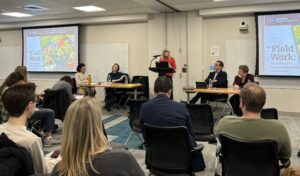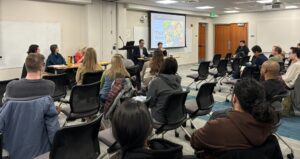“Field Work” Spring Symposium Maps Uncharted Territory of Academic Publishing

The 2024 CALS Spring Symposium was, by CALS director Sean Goudie’s own admission, “partly a selfish topic.” Realizing that many of his fellow English colleagues worked on academic journals, Goudie was curious to learn more about the often “underestimated ways” editors can “impact the scholarly landscape.” The attendees gathered in Pattee Library’s Dewey Room on March 18, many of whom were graduate students and other early-career academics, learned not only about the role editors play in shaping their respective fields, but also, and importantly, how they support and develop the work of emerging scholars.

“Field Work: Journal Editors on Shaping Intellectual Life in the Academy” featured four panelists who edit journals representing a range of subfields within literary and cultural studies. Three Penn State professors—Janet Lyon (co-editor, Journal of Modern Literature), Benjamin Schreier (editor, Studies in American Jewish Literature), and Tina Chen (editor, Verge: Studies in Global Asias)—were joined by Sarah Chinn of Hunter College, co-editor of J19: The Journal of Nineteenth-Century Americanists. Their conversation was moderated by Joseph Glinbizzi, a graduate student in Penn State’s English department and outgoing managing editor of Studies in American Jewish Literature.
Chinn kicked off the panel by describing the novel editorial structure of J19. A pair of co-editors (currently Chinn and Brigitte Fielder of the University of Wisconsin-Madison) serve five-year terms. Though these terms are technically renewable, Chinn explained that each editorial duo so far in the journal’s eleven-year history has stepped down after one term. These regular editorial changeups help ensure the journal remains “more than a reflection of a single editor” and furthers its mission to serve “as an incubator” for scholarly innovation.
In contrast, Schreier is only the second ever editor of SAJL, founded in 1975 by late Penn State professor Daniel Walden. This editorial cohesion is at odds, in Schreier’s telling, with a lack of disciplinary, epistemological, and institutional “coherence” within the field of Jewish-American literary studies itself. As editor, he strives to publish scholarship that can form the basis of a more “vibrant, challenging, [and] engaged” field of study.

In her role with JML, Lyon has witnessed firsthand the evolution of her own field. Since the journal’s founding in 1977, said Lyon, modernist literary studies has moved past the “periodization” or “big author” model, now operating within a “global penumbra” that encompasses literature from 1900 to the ever-expanding present. Lyon described the nine-person editorial team as “kind of a commune,” albeit an industrious one that willingly takes on “a huge workload.”
In founding Verge, Chen also envisioned a more communal kind of scholarship. One of her goals with the journal is “nurturing scholarly community” and fostering collaboration. Because Global Asias itself is a field originated and elaborated by Verge, the journal has “an unusual relationship to the [job] market” that “puts more of a responsibility on us.” By promoting “dynamic engagement” from all contributors, Verge has created a welcome, supportive community that empowers authors to move onto other roles within the journal as advisory board members or special issue editors.
The fluidity of these transitions is unsurprising, in Chen’s account, because editing straddles the three main forms of scholarly activity: teaching, research, and service. To that end, Chinn emphasized the editorial imperative to “invest time in responding to [submissions], much like we would the work of our students.” This practice, known as developmental editing, is embraced by all four panelists. Lyon called it a way to “make a brutal profession more humane.”

After discussing their individual (but overlapping) approaches to editorial work, the panelists took questions from the audience. The first was posed by Morgan Hamill, a graduate student in Penn State’s English department and outgoing managing editor of Verge. Hamill asked the editors to elaborate on the logistics of putting together a journal, that is, what the work looks like “on the ground.”
Chinn described the process of reading manuscripts, assigning viable ones to appropriate members of the editorial board for peer review, making additional edits as needed to accepted manuscripts, and putting articles into print within a year from final edits. “I know it feels mysterious,” she said of the process, “[but] it’s not magic.”
Schreier offered further insight into the editorial impetus behind offering an R&R to an author, which means inviting them to revise and resubmit their work after making requested changes. Because part of SAJL’s mission is “establishing scholarly ground,” Schreier tries not to be overly prescriptive in his feedback: “I don’t want to be the one telling you what [to change],” he said, “[because] I don’t want to be the one defining the field.”
Similarly, Chinn noted that R&Rs to J19 must be accompanied by a rationale from the author as to what peer-review feedback they incorporated and what they ignored. This encourages authors to take intellectual ownership of their work and fulfills what Lyon described as a journal’s “pedagogical obligation” to early-career scholars.
Chen discussed her own shifting relationship to academic journals, which early on she saw as a mere “outlet,” something to provide “a line on my CV and professional advancement.” But serving as an editor, she said, “opened my eyes to an entirely different way of thinking about the nature of the work we do.”
Adaptability, as each panelist observed, is necessary not only to the success of the individual academic, but also to the enterprise of academic publishing writ large. As Schreier joked, “Staying curious is the only thing that keeps me alive.” For academic journals, their vitality comes from the very work they publish, work that reflects the history of the field but also endeavors—with the help of kind, committed editors—to push the boundaries of that field in exciting new directions.

The 2024 CALS Spring Symposium was, by CALS director Sean Goudie’s own admission, “partly a selfish topic.” Realizing that many of his fellow English colleagues worked on academic journals, Goudie was curious to learn more about the often “underestimated ways” editors can “impact the scholarly landscape.” The attendees gathered in Pattee Library’s Dewey Room on March 18, many of whom were graduate students and other early-career academics, learned not only about the role editors play in shaping their respective fields, but also, and importantly, how they support and develop the work of emerging scholars.

“Field Work: Journal Editors on Shaping Intellectual Life in the Academy” featured four panelists who edit journals representing a range of subfields within literary and cultural studies. Three Penn State professors—Janet Lyon (co-editor, Journal of Modern Literature), Benjamin Schreier (editor, Studies in American Jewish Literature), and Tina Chen (editor, Verge: Studies in Global Asias)—were joined by Sarah Chinn of Hunter College, co-editor of J19: The Journal of Nineteenth-Century Americanists. Their conversation was moderated by Joseph Glinbizzi, a graduate student in Penn State’s English department and outgoing managing editor of Studies in American Jewish Literature.
Chinn kicked off the panel by describing the novel editorial structure of J19. A pair of co-editors (currently Chinn and Brigitte Fielder of the University of Wisconsin-Madison) serve five-year terms. Though these terms are technically renewable, Chinn explained that each editorial duo so far in the journal’s eleven-year history has stepped down after one term. These regular editorial changeups help ensure the journal remains “more than a reflection of a single editor” and furthers its mission to serve “as an incubator” for scholarly innovation.
In contrast, Schreier is only the second ever editor of SAJL, founded in 1975 by late Penn State professor Daniel Walden. This editorial cohesion is at odds, in Schreier’s telling, with a lack of disciplinary, epistemological, and institutional “coherence” within the field of Jewish-American literary studies itself. As editor, he strives to publish scholarship that can form the basis of a more “vibrant, challenging, [and] engaged” field of study.

In her role with JML, Lyon has witnessed firsthand the evolution of her own field. Since the journal’s founding in 1977, said Lyon, modernist literary studies has moved past the “periodization” or “big author” model, now operating within a “global penumbra” that encompasses literature from 1900 to the ever-expanding present. Lyon described the nine-person editorial team as “kind of a commune,” albeit an industrious one that willingly takes on “a huge workload.”
In founding Verge, Chen also envisioned a more communal kind of scholarship. One of her goals with the journal is “nurturing scholarly community” and fostering collaboration. Because Global Asias itself is a field originated and elaborated by Verge, the journal has “an unusual relationship to the [job] market” that “puts more of a responsibility on us.” By promoting “dynamic engagement” from all contributors, Verge has created a welcome, supportive community that empowers authors to move onto other roles within the journal as advisory board members or special issue editors.
The fluidity of these transitions is unsurprising, in Chen’s account, because editing straddles the three main forms of scholarly activity: teaching, research, and service. To that end, Chinn emphasized the editorial imperative to “invest time in responding to [submissions], much like we would the work of our students.” This practice, known as developmental editing, is embraced by all four panelists. Lyon called it a way to “make a brutal profession more humane.”

After discussing their individual (but overlapping) approaches to editorial work, the panelists took questions from the audience. The first was posed by Morgan Hamill, a graduate student in Penn State’s English department and outgoing managing editor of Verge. Hamill asked the editors to elaborate on the logistics of putting together a journal, that is, what the work looks like “on the ground.”
Chinn described the process of reading manuscripts, assigning viable ones to appropriate members of the editorial board for peer review, making additional edits as needed to accepted manuscripts, and putting articles into print within a year from final edits. “I know it feels mysterious,” she said of the process, “[but] it’s not magic.”
Schreier offered further insight into the editorial impetus behind offering an R&R to an author, which means inviting them to revise and resubmit their work after making requested changes. Because part of SAJL’s mission is “establishing scholarly ground,” Schreier tries not to be overly prescriptive in his feedback: “I don’t want to be the one telling you what [to change],” he said, “[because] I don’t want to be the one defining the field.”
Similarly, Chinn noted that R&Rs to J19 must be accompanied by a rationale from the author as to what peer-review feedback they incorporated and what they ignored. This encourages authors to take intellectual ownership of their work and fulfills what Lyon described as a journal’s “pedagogical obligation” to early-career scholars.
Chen discussed her own shifting relationship to academic journals, which early on she saw as a mere “outlet,” something to provide “a line on my CV and professional advancement.” But serving as an editor, she said, “opened my eyes to an entirely different way of thinking about the nature of the work we do.”
Adaptability, as each panelist observed, is necessary not only to the success of the individual academic, but also to the enterprise of academic publishing writ large. As Schreier joked, “Staying curious is the only thing that keeps me alive.” For academic journals, their vitality comes from the very work they publish, work that reflects the history of the field but also endeavors—with the help of kind, committed editors—to push the boundaries of that field in exciting new directions.